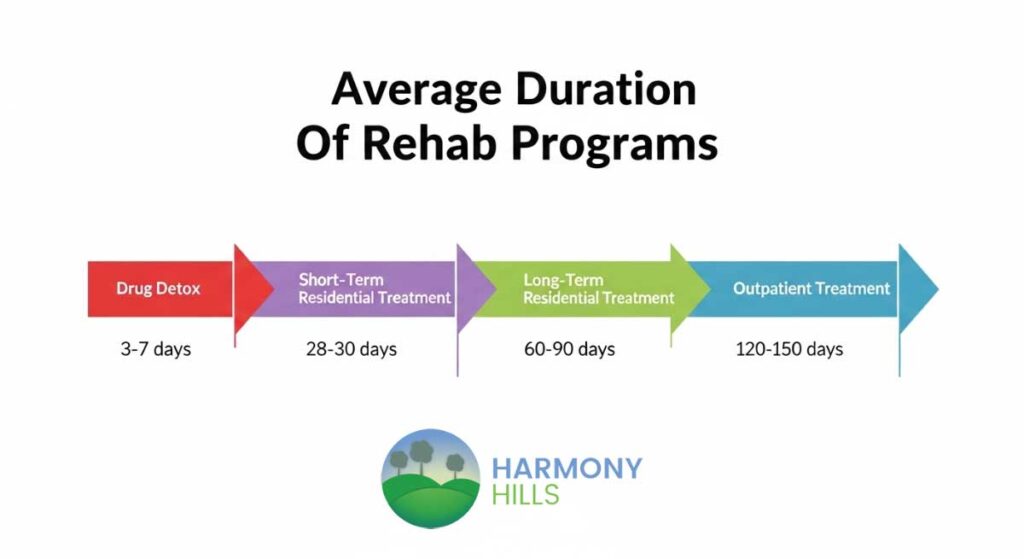Substance use disorders (SUDs) are complex illnesses. They need treatment plans made just for each person. A key part of addiction recovery is how long treatment lasts. This part is often not clear. Knowing the different timeframes helps people and their families. It sets real hopes and shows a clearer path forward. This article explains rehab duration. It breaks down the main stages and factors. This will help you make smart choices for lasting recovery.
Addiction is not the same for everyone. Its treatment is not either. The journey from addiction to recovery has many parts. Treatment length is a big changing factor. Things like the type of drug, how bad the addiction is, and other mental health issues all matter. How a person responds to therapy also plays a big role. These things help decide how long someone needs to stay in a rehab program.
The Crucial First Step: Detoxification
What is Detoxification?
Medical detox is the first step in treating addiction. It helps the body safely remove drugs or alcohol. This process manages the tough physical side effects of stopping drug use. These are called withdrawal symptoms. Doctors and nurses closely watch patients during this time. They give medicine to ease discomfort and keep the person safe. The main goal is to get through withdrawal safely and comfortably.
Common withdrawal symptoms differ by substance. For opioids, you might feel muscle aches, nausea, or anxiety. Alcohol withdrawal can cause tremors, seizures, or even delirium. Benzodiazepine withdrawal can lead to severe anxiety, seizures, or confusion. Medical teams help manage these intense feelings and risks.
How Long Does Detox Typically Last?
Detox usually takes a few days to a week. For some drugs, it might be shorter. Others, like benzodiazepines or long-acting opioids, can take longer. The exact length depends on several factors. These include the type of substance used and how much was used. How long someone has been using also affects detox time.
Detox is only the start of the recovery journey. It cleanses the body but does not address the mental side of addiction. Finishing detox is important. But it is never enough for full, lasting recovery. More treatment is always needed after detox.
Inpatient vs. Outpatient: Differentiating Treatment Modalities
Inpatient Rehabilitation (Residential)
Inpatient rehab offers round-the-clock care. People live at the treatment center. This provides a safe, structured setting. Patients are away from daily triggers to use drugs. They get constant support from staff and peers. The environment focuses on healing and intense therapy.
Benefits include deep individual and group therapy sessions. There is always medical support if needed. This setting lets people fully focus on their recovery. Common stays are 30, 60, or 90 days. Longer inpatient stays often lead to better outcomes. This means people are more likely to stay sober.
Outpatient Rehabilitation (Ambulatory)
Outpatient rehab offers more freedom. Patients live at home and go to scheduled therapy. This includes programs like Intensive Outpatient Programs (IOP) or Partial Hospitalization Programs (PHP). IOP often involves several hours of therapy a few days a week. PHP might be full-day sessions, similar to inpatient, but without staying overnight.
A big benefit is keeping up with work or family life. Outpatient care costs less than inpatient programs. It also helps people connect with support systems in their daily lives. Outpatient care is best for those with stable home lives. It works well for people with less severe addictions. It’s also good as a step-down from inpatient care.
The Core of Recovery: Therapy and Treatment Programs
Evidence-Based Therapies in Rehab
Rehab uses different kinds of therapy to help people. These therapies address the thinking and feelings behind addiction. Cognitive Behavioral Therapy (CBT) helps change harmful thoughts and behaviors. Dialectical Behavior Therapy (DBT) teaches skills for managing emotions. It also helps with stress and relationships.
Motivational Interviewing helps people find their own reasons to change. Trauma-informed care deals with past hurtful experiences. Group therapy provides a safe place to share. It offers support and helps people feel less alone. These therapies teach vital skills for staying sober.
Duration of Core Treatment
The length of core therapy depends on many things. How bad the addiction is matters. So do any other mental health problems. A person’s progress in therapy also guides the length. This is called “treatment matching.” It means the therapy fits the person’s exact needs.
It is very important to finish the whole treatment plan. Experts like the National Institute on Drug Abuse (NIDA) say this. They note that staying in treatment for at least 90 days shows the best results. This longer time allows for deep changes in behavior and thinking. It builds strong tools for a sober life.
Beyond Initial Treatment: Extended Care and Aftercare
Extended Care and Transitional Living
Extended care bridges the gap after intensive rehab. It helps people move from structured treatment back to daily life. This often includes living in a sober living home. These homes offer a safe, drug-free place to live. They have rules and structure.
Sober living homes provide peer support and accountability. This helps people practice new skills in real-world settings. They learn to avoid triggers and prevent relapse. The typical stay in extended care can range from a few months to over a year. It gives individuals time to build a solid foundation for lasting recovery. For example, someone might go from a 30-day inpatient program to six months in a sober living house.
Aftercare and Ongoing Support
Aftercare is key to staying sober for the long term. Recovery is a journey that lasts a lifetime. Aftercare plans help prevent relapse. They give ongoing support once formal treatment ends. This stage is vital for a strong recovery.
Aftercare includes many things. Attending support groups like Alcoholics Anonymous (AA) or Narcotics Anonymous (NA) is common. Continuing individual therapy helps too. Alumni programs at rehab centers offer ongoing connections. A strong relapse prevention plan is a must. Staying involved in these support systems makes a big difference. Studies show that people who engage in aftercare are more likely to stay sober. They have a better chance at lasting recovery.
Factors Influencing Rehab Duration
Substance Type and Severity of Addiction
The kind of substance used changes treatment needs. For example, withdrawing from stimulants is different from opioids. Each drug affects the brain and body uniquely. This impacts how long a person needs support. How long someone has used drugs also matters. Heavy, long-term use often needs longer treatment. The dosage of drugs used also plays a part.
Doctors use addiction severity scales. These help measure how bad the addiction is. A higher score often means a longer, more intensive treatment plan. Each person’s journey is unique. The treatment must match their specific challenges.
Co-occurring Disorders and Individual Needs
Many people with addiction also have mental health issues. This is called a dual diagnosis. Examples include depression, anxiety, or bipolar disorder. Treating both addiction and mental health problems at the same time is crucial. This often means a longer rehab stay. It gives enough time to address all issues.
Each person’s journey to recovery is personal. Things like a person’s inner strength, desire to change, and family support matter. These factors can affect how long treatment is needed. An expert might say that a one-size-fits-all approach to rehab length doesn’t work. They would stress the need for a personalized plan. This plan should look at all parts of a person’s life.
Conclusion
Treatment for substance use disorder is a journey. It is not a quick fix. Knowing how long rehab might take is very important for success. The first step is detox. This can last a few days. Then comes core treatment. This often takes 30 to 90 days or even longer. After that, vital aftercare and ongoing support follow. Every stage helps build lasting sobriety.
The best treatment plans are made for each person. They consider the drug used and how bad the addiction is. Other mental health issues and personal life also play a role. There is no set timeline for everyone. But studies clearly show longer treatment leads to better results. Staying connected to aftercare greatly lowers the chance of relapse. Learning about these stages helps you or a loved one. It is a key step towards lasting sobriety and a happy life.






